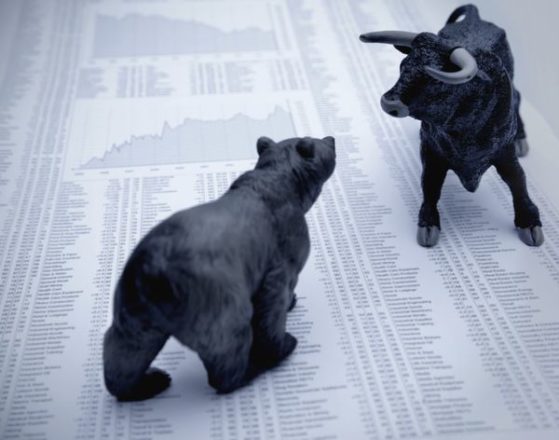Market volatility invariably affects the ways in which many Americans view investing.
The seemingly unpredictable nature of the stock market — and the ways in which normally rational individuals react to drastic, quick changes in the market — informs public opinion far more than the quiet periods of slow, solid growth.
Investing in volatile markets can be nerve-wracking, and decisions about which investments are best during periods of financial fluctuation are often filled with second-guesses. Here’s a breakdown of some key strategies to maintaining solid portfolio performance — and how to handle assets when the going gets rough.
What Is Market Volatility?
Market volatility is defined by the degree of price swings seen in financial markets over a short period of time — in both positive and negative directions. Financial assets are seen as volatile when they both increase and decrease in price over a relatively short period.
“Market volatility represents the ups and downs of the stock market,” says certified financial planner Carlos Valadez of Victory Capital. “It can also be defined as the rate that a financial security increases or decreases for a set of returns.”
During periods of normal, healthy economic activity, market volatility tends to be lower, meaning that the prices of stocks and similar assets tend to remain roughly the same and investors tend to trade at normal volumes.
Inevitably, however, something happens to cause market fluctuation.
Some commonly cited changes include shifts in government policies, wide-reaching events within the country (or abroad), new forecasted economic data, or more recently, developments in global health.
These events inevitably breed their fair share of optimism (or pessimism) about the financial future, which drives investor behaviors. And with enough investors buying (or selling) financial securities, these reactions invariably affect financial markets at large.
For example, projections of an imminent recession might lead many investors to react against the market, selling off assets and trading quickly and in high volumes — characteristics that define periods of high market volatility.
What Does Volatility Mean for the Stock Market?
Excess volatility in the stock market usually means two things: asset prices changing unexpectedly, and lots of buying and selling.
When the market is volatile, investors are often fearful their holdings will lose value.
This behavior is the expected emotional reaction by many stockholders, but it doesn’t mean it’s the right reaction.
Most financial experts will recommend that individuals seeking to grow their wealth keep a steely resolve, choosing not to liquidate their holdings when fear and/or panic set in.
“As a certified financial planner, I tell members to look at the big picture — look five years down the road and not to panic or react on emotion when markets are experiencing extreme volatility,” says Valadez.
And though many investors are aware that this is the right decision, the actions of their peers, the 24/7 news cycle, and the ability to sell on one’s own after trading hours can lead to irrational choices.
But an investor who understands market volatility knows that the best decision in the end is to stay the course and to unplug from naysayers and bad influences.
“I tell my clients there is a lot of news out there, some credible, but some that will try to throw you off course from achieving your goals,” recommends Valadez, reminding investors to remember their objectives and that risk is always part of the equation when investing.
How Should I Invest in a Volatile Market?
Attempting to “time the market” — essentially buying a stock low and selling it when it’s high — during periods of volatility can have significantly negative consequences on a portfolio’s value. Individuals with a greedy mindset often end up playing the stock market less like an investor and more like a gambler.
When it comes to investing in volatile markets, a sound investment strategy should boil down to one word: diversification.
Diversification refers to the practice of purchasing varying, different investments. This can mean purchasing stocks across a number of industries, and buying a mix of different asset types such as company stocks, government bonds, mutual funds, exchange traded funds, and real estate.
A solid portfolio should mitigate risk on both levels — the Securities and Exchange Commission (SEC) recommends investors diversify both between asset categories and within them.
Many investors also rebalance their asset allocation, selling off some of one asset and purchasing another, as they get older or as circumstances change in their life. This is because individuals differ in terms of their willingness to accept risk.
“When someone is getting closer to retirement, their investment objective has possibly changed from ‘growth’ to ‘income,’” says Valadez. “They are looking at being more conservative due to the need to start drawing funds,” either in the present or in the near future.
Understanding Bear and Bull Markets
A diverse portfolio better ensures solid, consistent growth during both periods of economic growth and decline — also known as bull and bear markets.
A bull market is a term used to describe periods when stock prices are up and investors are excited about future growth, typically when there’s a rise of 20 percent across the board, according to the SEC.
Conversely, declining stock values and pessimistic markets are traits of a bear market.
Both bull and bear markets are inherent to the boom-bust cycle of the economy.
Most investors know this, and face two options: Either attempt the impossible and time the market to try and win big, or understand the risk inherent to investing, endure periods of sluggish or negative growth, and realize larger gains in the long term.
Rather than pumping thousands of dollars into a single hot stock, a more salient approach might be to invest a set amount of money into the stock market at regular intervals.
For example, instead of buying a particular number of shares, an investor could set aside $100 per month toward investments. In doing so, the investor purchases more shares when their price is lower and fewer shares when their price is higher.
This strategy is referred to as dollar-cost averaging, and it’s a popular approach to investing; individuals who set aside a part of their paycheck for a 401(k) are likely well aware of its benefits.
“By utilizing a dollar-cost averaging strategy, investors will buy shares at higher or lower prices over time, which is an effective tool to build wealth,” says Valadez.
In general, when the market begins to slow or flame out, dollar-cost averaging can be a solid strategy for investing in weak or volatile markets.
By purchasing a set dollar amount of shares each month, the net effect is that the investor achieves a lower purchase price for their shares than if they had purchased all of their shares at an average or above price.
Moreover, as stated previously, it’s key not to offload an entire portfolio when markets head south. And if an investor decides to trade stock in a volatile market, they should be particularly careful to assure they aren’t acting irrationally or selling off assets that might recover in the future.
What to Learn from a Volatile Market
Volatile markets present an opportunity to examine spending beyond buying and trading assets, especially given that they can signal future economic stagnation or recession. Re-examining a household budget can help determine where spending can be cut back
This is particularly true for households who have suffered from lifestyle inflation — a process where increased earnings over time lead consumers to spend more.
Beyond seeing where they can save more, saving the money that might otherwise be invested during a period of normal economic activity can help mitigate the uncertainty of a potential recession, and provide more cash for day-to-day expenses.
With regards to assets, even as periods of market volatility continue, it’s key that investors focus on their long game.
Early professional and middle-aged investors should maintain a diversified portfolio throughout market dips so they are well-prepared to make up their losses as the economy bounces back — and historical cycles show that it will, inevitably, recover.
Investors nearing retirement, however, face a steeper, uphill battle, and may be worried about how to overcome a volatile market so they have more money to spend in their lives post work.
To that end, it may be better for more senior investors to delay retirement and/or cashing in on Social Security. This can provide more time to wait for a bull market to re-emerge, and for their portfolio to recover.
Investors nearing retirement may also benefit from consulting with a financial professional to see how their portfolios can be modified to adjust to market changes.
“I would conduct an investment review to see if investors nearing retirement have enough time to wait for a market recovery — which can be as long as five years,” says Valadez.
“If not, we would have to reallocate the portfolio and make their holdings more conservative and update their time horizon,” meaning an investor may have to wait longer to liquidate these asset holdings.
Regardless of where an investor is in their wealth-building journey, they should consult with their financial advisor, if they have one, throughout a volatile period. This can allow them to assess the damage to their assets, understand how they might recover, and clarify short- and long-term financial goals.
The Bottom Line
Much like death and taxes, market volatility is inescapable — and it’s also completely normal. It’s a risk that comes with owning assets, and while its wild movements put investors on edge and ready to sell, investors should remember that it’s usually best to wait it out.
“Unless your objective or risk tolerance has changed, there is no need to react to market volatility and make sudden changes,” recommends Valadez.
Historically, the stock market has seen more bulls than bears, according to analysis by the Federal Reserve. So even during the darkest night, keep a diversified portfolio close, and wait out the storm in confidence.




